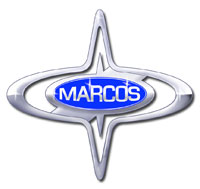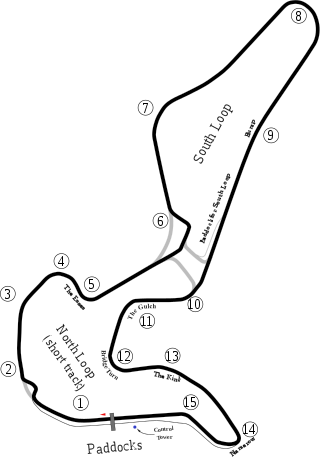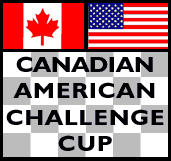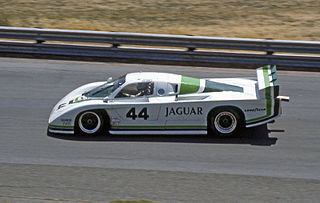The 1977 Can Am season was the tenth running of the Sports Car Club of America's prototype-based series.
Despite the revived name, however, the new series was entirely unrelated to the previous series which had folded in 1974.
Most of the competitive cars were based on Formula 5000 chassis. Also, the first time under 2-litre cars were allowed to race, but with no separate class.
Patrick Tambay was the season champion, [1] winning six of the nine races that year for Carl Haas.
While Lola chassis dominated the series, a Chevrolet powered Schkee DB1 driven by Tom Klausler won the first race at Mont Tremblant. [2]
Other competitive cars included the 1974 champions Shadow, who now used Dodge engines and Wolf with a Dallara-built chassis.
While Chevrolet was not the only engine supplier, they swept the entire season.
This season also marked a resurgence of interest in SCCA events, with Can Am accompanying F5000 and the Trans Am Series seeing a mild resurgence in the eighties.
It is indeed very hard to find any available source containing the points scoring system for this Can-Am season.

Marcos Engineering was a British sports car manufacturer. The name derives from the surnames of founders Jem Marsh and Frank Costin.
The Surtees Racing Organisation was a race team that spent nine seasons as a constructor in Formula One, Formula 2, and Formula 5000.

The Porsche 917 is a sports prototype race car developed by German manufacturer Porsche to exploit the regulations regarding the construction of 5-litre sports cars. Powered by a Type 912 flat-12 engine which was progressively enlarged from 4.5 to 5.0 litres, the 917 was introduced in 1969 and initially proved unwieldy on the race track but continuous development improved the handling and it went on to dominate sports-car racing in 1970 and 1971. In 1970 it gave Porsche its first overall win at the 24 Hours of Le Mans, a feat it would repeat in 1971. It would be chiefly responsible for Porsche winning the International Championship for Makes in 1970 and 1971. Porsche went on to develop the 917 for Can-Am racing, culminating in the twin-turbocharged 917/30 which was even more dominant in the role. Porsche drivers would win the Can-Am championship in 1972 and 1973. 917 drivers also won the Interserie championship every year from 1969 to 1975.

Circuit Mont-Tremblant is a 4.218 km (2.621 mi) race circuit located approximately 130 km (81 mi) north of Montreal, Quebec, in the city of Mont-Tremblant, Canada. It is the second-oldest existing race track in Canada, and was originally known as Circuit Mont-Tremblant-St-Jovite until it was renamed in the 1970s. Set in the shadow of the Mont-Tremblant ski hill, the twisting fifteen-corner track uses the natural topography and elevation of the land.

The Canadian-American Challenge Cup, or Can-Am, was an SCCA/CASC sports car racing series from 1966 to 1974, and again from 1977 to 1987.
The Ferrari P was a series of Italian sports prototype racing cars produced by Ferrari during the 1960s and early 1970s.

Formula 5000 was an open wheel, single seater auto-racing formula that ran in different series in various regions around the world from 1968 to 1982. It was originally intended as a low-cost series aimed at open-wheel racing cars that no longer fit into any particular formula. The '5000' denomination comes from the maximum 5.0 litre engine capacity allowed in the cars, although many cars ran with smaller engines. Manufacturers included McLaren, Eagle, March, Lola, Lotus, Elfin, Matich and Chevron.

Bill Adam is a Canadian racing driver born in Airdrie, North Lanarkshire, Scotland.

A Daytona Prototype was a type of sports prototype racing car developed specifically for the Grand American Road Racing Association's Rolex Sports Car Series as their top class of car, which replaced their main prototype racing class, specifically Le Mans Prototypes (LMPs). The cars later competed in the merged series of the IMSA SportsCar Championship, from 2014 to 2016, before being phased out and replaced by the Daytona Prototype International class in 2017. They are named after the main series event, the Rolex 24 at Daytona.
The Alfa Romeo Tipo 33 was a sports racing prototype raced by the Alfa Romeo factory-backed team between 1967 and 1977. These cars took part for Sport Cars World Championship, Nordic Challenge Cup, Interserie and CanAm series. A small number of road going cars were derived from it in 1967, called Alfa Romeo 33 Stradale.
The 1968 Trans-American Championship was the third running of the Sports Car Club of America's Trans-Am Series. 1968 marked the addition of the 12 Hours of Sebring and the 24 Hours of Daytona, the only year that the Trans-Am Series featured those races. The season also marked the first time that an event was held outside of the United States, when a race at Mont-Tremblant brought Trans-Am into Quebec, Canada.
The 1978 Can-Am season was the eleventh running of the Sports Car Club of America's prototype based series and the second running of the revived series. Alan Jones was declared champion, winning five of the ten rounds. Chevrolet again swept the season. Lola was not as dominant this season, as Elliot Forbes-Robinson won at Charlotte in a Spyder, SCCA legend George Follmer at Mont Tremblant in a Prophet, and Forbes-Robinson again at Trois-Rivieres.
The 1979 Can-Am season was the twelfth running of the Sports Car Club of America's prototype-based series and the third running of the revived series. Formula One legend Jacky Ickx was declared champion, winning five of the ten rounds and finishing second at Road Atlanta. Chevrolet again dominated the season. The top chassis builders were Lola, Prophet, and Spyder, with Vern Schuppan finishing third at Watkins Glen in an Elfin and Al Holbert finishing third at Road America in a Hogan.
The 1981 Can Am series season was the fourteenth running of the Sports Car Club of America's prototype-based series, and the fifth running of the revived series. Geoff Brabham was declared champion, despite only winning two races. Chevrolet again dominated the season. The dominant chassis manufacturers were March, Lola, Holbert, Frissbee, and VDS. IndyCar drivers Al Unser and Bobby Rahal also podiumed at Road America and Mosport, respectively.
The 1982 Can Am Series season was the fifteenth running of the Sports Car Club of America's prototype series, and the sixth running of the revived series. 1982 brought new competition for Chevrolet in the form of Hart and Cosworth. Hart would podium in three races while Cosworth would podium in two. The most dominant chassis were Frissbee, Marguey, March, VDS-001, and Ensign. Al Unser Jr. would win at Road Atlanta, Laguna Seca, and Mosport twice, with a podium at Mid Ohio, at Riverside, and at Caesar's Palacae. Unser would be declared champion.
The 1983 Can Am season was the sixteenth running of the Sports Car Club of America's prototype series and the seventh of the revived series. 1983 marked the second year of Chevrolet having major competition, with Cosworth taking second at Mosport, first at Lime Rock, second at Trois-Rivières, first at the second race at Mosport, and second at Sears Point. Hart would take third at Lime Rock and third at Trois-Rivières. Porsche would get its first podiums this season, with a win at Road America and third at the second race at Mosport. The dominant chassis were Frissbee, Ensign, Lola, VDS, Scandia, and Ralt. Jacques Villeneuve, Sr. was declared champion, with podiums in almost every race. He would, however, become the final major racecar driver to win a Can Am championship.
The 1984 Can Am season was the seventeenth running of the Sports Car Club of America's prototype series, and the eighth running of the revived series. 1984 would mark a major downturn in the series, as Juan Manuel Fangio II would become the last major driver to podium in a Can Am Series race, finishing third at Dallas. The dominant manufacturers were Chevrolet, Hart, BMW for the first time with a third-place finish at Brainerd, Cosworth, Lola, Ralt, and March. Dominant chassis were VDS, March, Frissbee-Lola, Ralt, and Williams with their first podium with a third-place finish at Lime Rock. Michael Roe was declared champion, with seven wins. The final race at Green Valley would feature the final truly notable driver in series history, John Andretti.

The Spyder NF-10 was an American sports prototype racing car built for the Can-Am series in 1978. It was based on a Lola T333CS, and was developed into the Spyder NF-11 in 1979. Two NF-10s were built in 1978, whilst four NF-11s were built in 1979, two of which were originally NF-10s. Both the NF-10 and NF-11 featured a 5-litre Chevrolet V8 engine.
The Surtees TS5 was a Formula 5000 racing car, designed, developed, and built by Surtees between 1969 and 1970.

The Lola T210, and its evolution, the Lola T212, are Group 6 sports prototype race cars, designed, developed and built by British manufacturer Lola, for the newly created European 2-Litre sports car racing championship, in 1970.